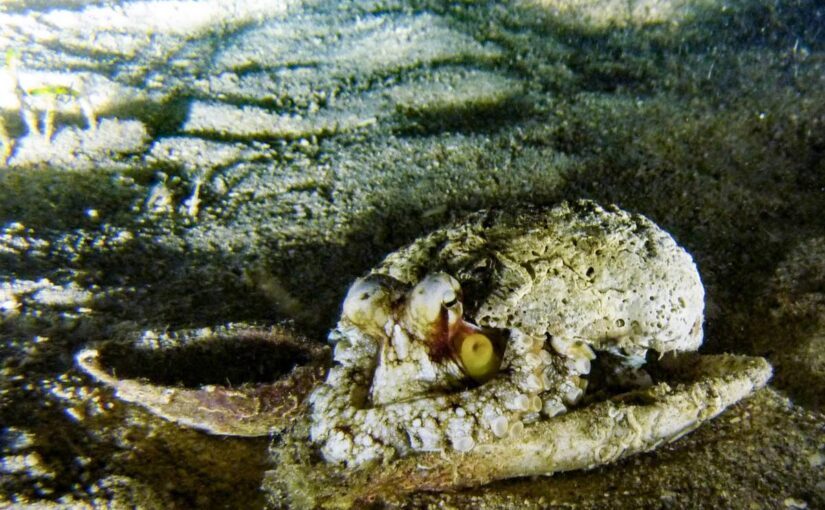A philosopher journeys into the world of comparative thanatology, which explores how animals of all kinds respond to death and dying.
Vous n'êtes pas connecté
- English
- Français
- عربي
- Español
- Deutsch
- Português
- русский язык
- Català
- Italiano
- Nederlands, Vlaams
- Norsk
- فارسی
- বাংলা
- اردو
- Azərbaycan dili
- Bahasa Indonesia
- Հայերեն
- Ελληνικά
- Bosanski jezik
- українська мова
- Íslenska
- Türkmen, Түркмен
- Türkçe
- Shqip
- Eesti keel
- magyar
- Қазақ тілі
- Kalaallisut ; kalaallit oqaasii
- Lietuvių kalba
- Latviešu valoda
- македонски јазик
- Монгол
- Bahasa Melayu ; بهاس ملايو
- ဗမာစာ
- Slovenščina
- тоҷикӣ ; toğikī ; تاجیکی
- ไทย
- O'zbek ; Ўзбек ; أۇزبېك
- Tiếng Việt
- ភាសាខ្មែរ
- རྫོང་ཁ
- Soomaaliga ; af Soomaali
Rubriques :
 Maroc - NEWSDAY.CO.TT - A la Une - 19/Sep 07:57
Maroc - NEWSDAY.CO.TT - A la Une - 19/Sep 07:57
Which creatures in the sea are using tools?
Not only humans use tools. Anjani Ganase looks at some marine animals that use objects in their environment to hide, hunt or eat. Tools are defined as objects derived from the environment, attached or unattached, used to complete tasks with greater efficiency or success. We often consider the use of tools exclusive human practices and the reason for our advancement in technology. However, tool use is common in the animal kingdom, and was first recorded by Dr Jane Goodall, who highlighted tool use for feeding by the great apes and chimpanzees. The scope of tool use was widened to include animals with limbs, hands, tails, etc capable of holding objects. The concept of “holding” an object was broadened again as researchers observed birds, dolphins and an array of animals using tools for feeding, protection, camouflaging, even for parenting and mating. The types of tools ranged from the very simple to highly sophisticated. Here are some marine animals that use tools. Hunting with water! Water manipulation is a very common type of tool use in the ocean. Orcas are the fiercest predators in the ocean. They cause great white sharks to flee and they can even rattle a big boat or two. [caption id="attachment_1109412" align="alignnone" width="1024"] Sea urchin wrapped up in blades of seagrass in Indonesia. - Anjani Ganase[/caption] Orcas are highly intelligent and one group of about 100 orcas, called B1 Orcas, that live in Antarctica have devised a sophisticated strategy for hunting prey on ice. They work together to use water as the tool to “wave wash” seals off their ice floes. The orcas would swim towards the ice floe in a line and in a synchronised fashion, they would dip their bodies under the floe and flap their tails to generate a wave strong enough to knock their prey off. The attack is highly co-ordinated and brutal to witness. Stingrays can propel water by wafting their fins over the sandy substrate to reveal buried prey, while other marine organisms, such as squid and cuttlefish, can blow jets of water into the sand for burrowing and camouflaging. Fish can blow water jets into the sand to reveal lurking predators such as bobbit worms; they also use water jets to waft and aerate their eggs. Blending in or hiding Marine animals utilise objects from their surroundings to blend in better and avoid predation. On my dives in Tobago, I’ve come across sea urchins that decorate themselves with shells, corals and even sticks. Take a very careful look under the sea urchin, and you may find a crab hiding out, also seeking protection under the spines. I’ve seen hermit crabs balancing pieces of sponge and soft corals on their shells while out on the reef foraging at night. Predators beware! In the Indo-Pacific, the boxer crab lives on coral reefs, walking around with two tiny anemones in its claws making them look like boxing gloves (or, in my opinion, pom-poms). Anemones have stinging cells that the crab would wave to deter any potential predators from taking a bite. The crab can also drag the anemone along the sand and feed on any tiny critters that get stunned by the anemone. Another peculiar adaptation in the shallow sandy or muddy habitats of the Indo-Pacific is the use of coconut shells and clam shells by veined and coconut octopus to hide or shield themselves. Sponging around for food Female dolphins in Shark Bay, Western Australia, use tools in an unusual way. Scientists observed that the dolphins would fit pieces of sponge to their beaks and use them to prod the substrate and stir up bottom-dwelling fish without damaging themselves. The fish are easy to capture and very nutritious. It is speculated that mothers developed this tactic to get quick and easy meals while raising their calves. Bubble fishing In Alaska, a small subset of humpback whales use a visually beautiful method for corralling krill or fish to eat. [caption id="attachment_1109411" align="alignnone" width="683"] Dolphins in Shark Bay, Western Australia. Photo courtesy Emilie Ledwidge/Ocean Image Bank -[/caption] The humpback whales create a bubble net by blowing a sequence of bubbles while swimming around in circles, with each consecutive circle becoming smaller and smaller. As the bubbles rise, a conical wall of bubbles is created to corral and trap prey. The whales can feed on a larger serving in just one gulp. This strategy is used by two per cent of the population, implying that it is only beneficial under certain conditions, otherwise the whales will simply engulf without using the bubble net. Researchers found that whales can often alter the sizes and the density of bubbles depending on the circumstances. Bubble nets can be formed by a solitary whale or several working together. The post Which creatures in the sea are using tools? appeared first on Trinidad and Tobago Newsday.
Articles similaires
Tools of the Trade: Courtney Cotrupe of Partners + Napier
Tools of the Trade is an AgencySpy feature to help highlight the many tools that help make advertising and marketing folks successful. The tools can...
Khawariji Terrorism: The TTP And ISKP Threat To Pakistan’s Stability – OpEd
Pakistan, a country with a rich cultural tapestry and a strategic geopolitical location, has been grappling with various security challenges. Among...
SURRENDER OR STARVE: Hundreds of illegal miners arrested after underground food and water supplies cut
The zama zamas who surfaced at Orkney over the weekend are the small fish in this big pond of criminality. The big fish have yet to be landed in the...
5 Ways To Ensure You’re Recycling Properly In Toronto
In the wake of a too-warm winter, a truly sweltering summer, and heavy rain days, environmental care has been at the top of everyone’s minds in...
Virtual reality the way forward for training
A training program where new forestry recruits learn to make crucial thinning decisions through immersive virtual reality simulations of forests could...
Beyond the Algorithm: How Human Analysts Bring Real Value to PR Measurement
By: Philip OdiakoseIn public relations, data-driven decision-making has become a pivotal element of PR success. The ability to accurately monitor...
How to Update or Downgrade Your Smartphone Without Jailbreak
Is your phone stuck at the boot screen after an update and the only way to fix it is to use an Android unlock tool to downgrade? Short of having to...
Challenges and Biblical Principles in Management Information
• Identify the major legal and ethical challenges and risks related to the use and abuse of corporate, personal, or private information. •...
Squirrels, whales, bears: why is the road to the White House strewn with dead animals?
Reports of casual cruelty to animals during the presidential race are more about gaining votes than concern for their welfare
Les derniers communiqués
-
Aucun élément






